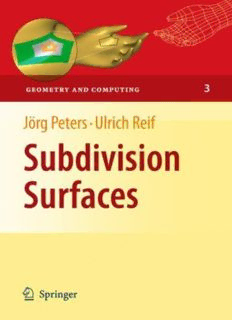
Subdivision Surfaces PDF
Preview Subdivision Surfaces
Geometry and Computing SeriesEditors HerbertEdelsbrunner LeifKobbelt KonradPolthier EditorialAdvisoryBoard Jean-DanielBoissonnat GunnarCarlsson BernardChazelle Xiao-ShanGao CraigGotsman LeoGuibas Myung-SooKim TakaoNishizeki HelmutPottmann RobertoScopigno Hans-PeterSeidel SteveSmale PeterSchro¨der DietrichStoyan • Jo¨rg Peters Ulrich Reif Subdivision Surfaces With 52 Figures 123 Jo¨rgPeters UlrichReif UniversityofFlorida TUDarmstadt Dept.Computer&InformationScience FBMathematik GainesvilleFL32611-6120 Schloßgartenstr.7 USA 64289Darmstadt [email protected]fl.edu Germany [email protected] ISBN978-3-540-76405-2 e-ISBN978-3-540-76406-9 SpringerSeriesinGeometryandComputing LibraryofCongressControlNumber:2008922290 MathematicsSubjectsClassification(2000):65D17,65D07,53A05,68U05 (cid:1)c 2008Springer-VerlagBerlinHeidelberg Thisworkissubjecttocopyright.Allrightsarereserved,whetherthewholeorpartofthematerialis concerned,specificallytherightsoftranslation,reprinting,reuseofillustrations,recitation,broadcasting, reproductiononmicrofilmorinanyotherway,andstorageindatabanks.Duplicationofthispublication orpartsthereofispermittedonlyundertheprovisionsoftheGermanCopyrightLawofSeptember9, 1965,initscurrentversion,andpermissionforusemustalwaysbeobtainedfromSpringer.Violations areliabletoprosecutionundertheGermanCopyrightLaw. Theuseofgeneraldescriptivenames,registerednames,trademarks,etc.inthispublicationdoesnot imply,evenintheabsenceofaspecificstatement,thatsuchnamesareexemptfromtherelevantprotective lawsandregulationsandthereforefreeforgeneraluse. Coverdesign:deblik,Berlin Printedonacid-freepaper 9 8 7 6 5 4 3 2 1 springer.com for Anousha Daniel Julian Kavina Tobias Preface AkintoB-splines,theappealofsubdivisionsurfacesreachesacrossdisciplinesfrom mathematics to computer science and engineering. In particular, subdivision sur- faces have had a dramatic impact on computer graphics and animation over the last 10 years: the results of a development that started three decades ago can be viewed today at movie theaters, where feature length movies cast synthetic char- acters ‘skinned’ with subdivision surfaces. Correspondingly, there is a rich, ever- growingliteratureonitsfundamentalsandapplications. Yet,aswitheveryvibrantnewfield,thelackofauniformnotationandstandard analysistoolshasaddedunnecessary,attimesinconsistent,repetitionthatobscures thesimplicityandbeautyoftheunderlyingstructures.Onegoalinwritingthisbook istohelpshortenintroductorysectionsandsimplifyproofsbyproposingastandard setofconceptsandnotation. Whenwestartedwritingthisbookin2001,wefeltthatthefieldhadsufficiently settled for standardization. After all, Cavaretta, Dahmen, and Micchelli’s mono- graph [CDM91] had appeared 10 years earlier and we could build on the habilita- tionofthesecondauthoraswellasanumberofjointpapers.Butitwasonlyinthe processofwritingandseeingtheissuesinconjunction,thatstructuresandnotation becameclearer.Infact,thelengthofthebookrepeatedlyincreasedanddecreased, askeyconceptsandstructuresemerged. Chapter2 ,forexample,wasalateaddition,asitbecameclearthatthedifferen- /15 tial geometry for singular parameterizations, of continuity, smoothness, curvature, and injectivity, must be established upfront and in generality to simplify the ex- positionandlaterproofs.Bycontrast,thekeydefinitionofsubdivisionsurfacesas splineswithsingularities,inChap.3 ,wasapartofthefoundationsfromtheoutset. /39 This point of view implies a radical departure from any focus on control nets and insteadplacesthemainemphasisonnestedsurfacerings,asexplainedinChap.4 . /57 Carefulexaminationofexistingproofsledtotheexplicitformulationofanumber of assumptions, in Chap.5 , that must hold when discussing subdivision surfaces /83 ingenerality.Conversely,placingthesekeyassumptionsupfront,shortenedthepre- sentationconsiderably.Therefore,thestandardexamplesofsubdivisionalgorithms vii viii Preface reviewed in Chap.6 are presented with a new, shorter and simpler analysis than /109 in earlier publications. Chapters 7 and 8 were triggered by very recent, new /125 /157 insights and results and partly contain unpublished material. The suitability of the majorknownsubdivisionalgorithmsforengineeringdesignwasattheheartofthe investigationsintotheshapeofsubdivisionsurfacesinChap.7 .Theshortcomings /125 of the standard subdivision algorithms discovered inthe process forced arenewed search for an approach to subdivision capable of meeting shape and higher-order continuity requirements. Guided subdivision was devised in response. The second partofChap.7 recaststhisclassofsubdivisionalgorithmsinamoreabstractform /125 that may be used as a prototype for a number of new curvature continuous subdi- vision algorithms. The first part of Chap.8 received a renewed impetus from a /157 recentstreamofpublicationsaimedatpredictingthedistanceofasubdivisionsur- face from their geometric control structures after some m refinement steps. The introduction of proxy surfaces and the distance to the corresponding subdivision surface subsumes this set of questions and provides a framework for algorithm- specificoptimalestimates.ThesecondpartofChap.8 grewoutofthesurprising /157 observationthattheCatmull–Clarksubdivisioncanrepresentthesamesphere-like objectstartingfromanymemberofawholefamilyofinitialcontrolconfigurations. The final chapter, Chap.9 , shows that a large variety of subdivision algorithms /175 is fully covered by the exposition in the book. But it also outlines the limits of ourcurrentknowledgeandopensawindowtothefascinatingformsofsubdivision currently beyond the canonical theory and to the many approaches still awaiting discovery. As a monograph, the book is primarily targeted at the subdivision community, including not only researchers in academia, but also practitioners in industry with aninterestinthetheoreticalfoundationsoftheirtools.Itisnotintendedasacourse textbookandcontainsnoexercises,butanumberofworkedoutexamples.However, weaimedatanexpositionthatisasself-containedaspossible,requiring,wethink, onlybasicknowledgeoflinearalgebra,analysisorelementarydifferentialgeometry. The book should therefore allow for independent reading by graduate students in mathematics,computerscience,andengineeringlookingforadeeperunderstanding ofsubdivisionsurfacesorstartingresearchinthefield. Two valuable sources that complement the formal analysis of this book are the SIGGRAPH course notes [ZS00] compiled by Schro¨der and Zorin, and the book ‘SubdivisionMethodsforGeometricdesign’byWarrenandWeimer[WW02].The notes offer the graphics practitioner a quick introduction to algorithms and their implementation and the book covers a variety of interesting aspects outside our focus; for example, a connection to fractals, details of the analysis of univariate algorithms,variationalalgorithmsbasedondifferentialoperatorsandobservations thatcansimplifyimplementation. Weaimedatunifyingthepresentation,placingforexamplebibliographicalnotes attheendofeachcorechaptertopointoutrelevantandoriginalreferences.Inaddi- tiontothese,weincludedalargenumberofpublicationsonsubdivisionsurfacesin Preface ix thereferencesection.Ofcourse,giventheongoinggrowthofthefield,thesenotes cannotclaimcompleteness.Wethereforereservedtheinternetsite www.subdivision-surface.org for future pointers and additions to the literature and theme of the book, and, just possibly,tomitigateanydamageofinsufficientproofreadingonourpart. Itisourpleasuretothankatthispointourcolleaguesandstudentsfortheirsup- port: Jianhua Fan, Ingo Ginkel, Jan Hakenberg, Rene´ Hartmann, Ke¸stutis Karcˇiauskas,MinhoKim,AshishMyles,TianyunLisaNi,AndyLeJengShiue, GeorgUmlauf,andXiaobinWuwhoworkedwithusonsubdivisionsurfacesover many years. JanHakenberg,Rene´Hartmann,MalcolmSabin,NeilStewart, and GeorgUmlaufhelpedtoenhancethemanuscriptbycarefulproof-readingandpro- viding constructive feedback. MalcolmSabinand GeorgUmlaufadded valuable materialforthebibliographicalnotes.NiraDynandMalcolmSabinwillinglycon- tributed two sections to the introductory chapter, and it was again Malcolm Sabin whosharedhisextensivelistofreferencesonsubdivisionwhichformedthestarting pointofourbibliography.ChandrajitBajajgenerouslyhostedaretreatoftheauthors thatbroughtaboutthefinalstructureofthebook.Manythankstoyouall!Thework wassupportedbytheNSFgrantsCCF-0430891andDMI-0400214. Ourfinalthanksarereservedforourfamiliesfortheirsupportandtheirpatience. Youkeptusinspired. Contents 1 IntroductionandOverview...................................... 1 1.1 RefinedPolyhedra.......................................... 1 1.2 ControlNets............................................... 2 1.3 SplineswithSingularities.................................... 4 1.4 FocusandScope ........................................... 6 1.5 Overview ................................................. 7 1.6 Notation .................................................. 7 1.7 AnalysisintheShift-InvariantSetting ......................... 8 1.8 HistoricalNotesonSubdivisiononIrregularMeshes............. 11 2 GeometryNearSingularities .................................... 15 2.1 DotandCrossProducts ..................................... 16 2.2 RegularSurfaces ........................................... 17 2.3 SurfaceswithaSingularPoint................................ 23 2.4 CriteriaforInjectivity....................................... 31 3 GeneralizedSplines ............................................ 39 3.1 AnAlternativeViewofSplineCurves ......................... 40 3.2 ContinuousBivariateSplines................................. 41 3.3 Ck-Splines................................................ 44 3.4 Ck-Splines................................................ 47 r 3.5 ABicubicIllustration ....................................... 53 4 SubdivisionSurfaces ........................................... 57 4.1 Refinability ............................................... 58 4.2 SegmentsandRings ........................................ 59 4.3 SplinesinFinite-DimensionalSubspaces....................... 65 4.4 SubdivisionAlgorithms ..................................... 67 4.5 AsymptoticExpansionofSequences .......................... 71 4.6 JordanDecomposition ...................................... 72 4.7 TheSubdivisionMatrix ..................................... 75 xi xii Contents 5 Ck-SubdivisionAlgorithms ..................................... 83 1 5.1 GenericInitialData......................................... 84 5.2 StandardAlgorithms........................................ 84 5.3 GeneralAlgorithms......................................... 89 5.4 ShiftInvariantAlgorithms ................................... 95 5.5 SymmetricAlgorithms ......................................103 6 CaseStudiesofCk-SubdivisionAlgorithms .......................109 1 6.1 Catmull–ClarkAlgorithmandVariants.........................109 6.2 Doo–SabinAlgorithmandVariants............................116 6.3 SimplestSubdivision .......................................120 7 ShapeAnalysisandCk-Algorithms ..............................125 2 7.1 HigherOrderAsymptoticExpansions .........................126 7.2 ShapeAssessment..........................................134 7.3 ConditionsforCk-Algorithms................................140 2 7.4 AFrameworkforCk-Algorithms .............................145 2 7.5 GuidedSubdivision.........................................149 8 ApproximationandLinearIndependence.........................157 8.1 ProxySplines..............................................157 8.2 LocalandGlobalLinearIndependence ........................169 9 Conclusion ....................................................175 9.1 FunctionSpaces............................................176 9.2 Recursion .................................................177 9.3 CombinatorialStructure .....................................178 References.........................................................183 Index .............................................................199
Description: